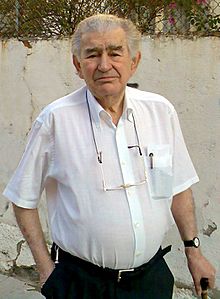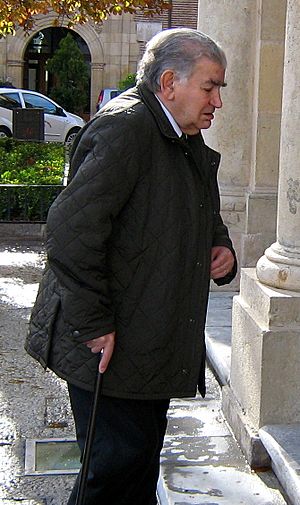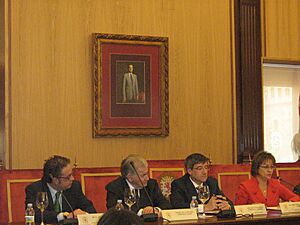Antonio Gamoneda facts for kids
Quick facts for kids
Antonio Gamoneda
|
|
|---|---|

León, 2007
|
|
| Born | Antonio Gamoneda Lobón 30 May 1931 Oviedo Asturias, Spain |
| Occupation | Poet |
| Nationality | Spanish |
| Notable awards | Miguel de Cervantes Prize 2006 |
Antonio Gamoneda Lobón is a famous Spanish poet. He was born on May 30, 1931. In 2006, he won the Cervantes Prize, which is one of the most important awards for writers in the Spanish language.
Contents
Antonio Gamoneda's Early Life
Antonio Gamoneda was born in Oviedo, Asturias, Spain, on May 30, 1931. His father, also named Antonio, was a poet who published one book. In 1934, when Antonio was very young, his father passed away. He then moved with his mother, Amelia Lobon, to León.
Growing Up During Difficult Times
The time Antonio was growing up was very challenging in Spain. Schools were closed because of the Spanish Civil War in 1936. Antonio learned to read by himself, using his father's book. His mother was a great comfort to him during these hard years. Her presence is often seen in his poems.
Antonio lived in a working-class area of León. This allowed him to see the difficulties people faced during and after the war.
School and First Job
In 1941, Antonio went to a religious school. He left school in 1943. On his fourteenth birthday, he started working as a messenger at a bank. He studied on his own to finish his high school education. He worked at the bank for 24 years, until 1969.
Antonio Gamoneda's Writing Journey
While working at the bank, Antonio became part of a group that quietly opposed the government at the time. In 1960, he published his first book of poems, called Sublevación inmóvil (which means Motionless Revolt). This book was different from the usual poetry written in Spain back then.
Promoting Culture
In 1969, Antonio started working for the cultural services in León. He also helped manage a poetry collection from 1970. He tried to support new and progressive ideas in culture. He even faced some challenges at work because of this, but he was later allowed to return. During these years, he also wrote for different cultural magazines.
A Time of Change and New Poetry
Antonio took an eight-year break from publishing poetry. This time was important because the old government leader, Francisco Franco, passed away. Spain then began a period called the "transición" (transition) to a democracy.
Antonio's next book, Descripción de la mentira (A Description of the Lie), came out in 1977. This long poem showed his mature writing style. Later, he published Lápidas (Tombstones) in 1987. All his poems up to 1987 were collected in a book called Edad (Age). This book won the National Prize for Literature in Spain.
Important Works and Awards
In 1992, Antonio published Libro del frío (Book of the Cold). This book helped him become known as one of the most important Spanish poets. A final version of this work came out in 2000. It included Frío de límites (Cold of Limits), which he created with artist Antoni Tàpies.
His book Arden las pérdidas (Losses Are Burning) was published in 2003. After that, he wrote Cecilia (2004), named after his granddaughter. He also released La luz: Collected Poetry: (1947–2004) in 2004.
In 2005, Antonio received the first European Prize for Literature. The next year, in 2006, he won the Reina Sofia Award and the Cervantes Prize. The Cervantes Prize is the highest honor a writer can receive in Spanish literature.
Antonio has also received other important awards. These include the Gold Medal of the city of Pau, the Silver Medal of Asturias, and the Gold Medal of the Círculo de Bellas Artes. He has also been given an honorary doctorate from the University of León.
A documentary film about him, called Antonio Gamoneda: Escritura y alquimia, was released in March 2009.
Antonio Gamoneda's Books
Antonio Gamoneda has written many books of poems. Here are some of his well-known works:
- Sublevación inmóvil (Motionless Revolt), 1960
- Descripción de la mentira (A Description of the Lie), 1977
- Blues castellano (Castilian Blues), 1982
- Lápidas (Gravestones), 1986
- Edad (Age), a collection of his poetry from 1947–1986
- Libro del frío (Book of the Cold), 1992
- Arden las pérdidas (Losses Are Burning), 2003
- Cecilia, 2004
- Esta luz (This Light), a collection of his poetry from 1947–2004
Translated Works
Antonio Gamoneda's poetry has been translated into many languages. This shows how important his work is around the world. Some of his translated books include:
- Pierres gravées (Gravestones) in French
- Livro do frio (Book of Cold) in Portuguese
- Beskrivning av lögnen (A Description of the Lie) in Swedish
- Boek van de kou (Book of Cold) in Dutch
- Gravestones and Description of the Lie in English
Other Writings
Besides poetry, Antonio Gamoneda has also written essays. These are non-fiction writings where he shares his thoughts on poetry and other topics. He has also collaborated with plastic artists, creating books that combine his poems with their artwork.
Images for kids
See also
 In Spanish: Antonio Gamoneda para niños
In Spanish: Antonio Gamoneda para niños






